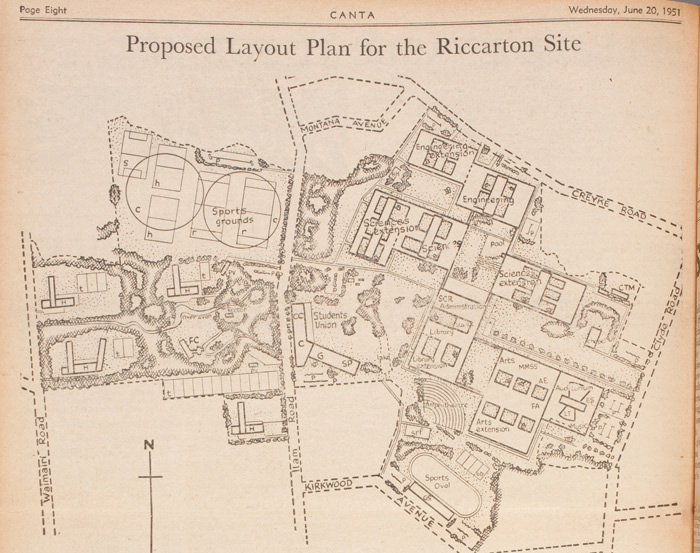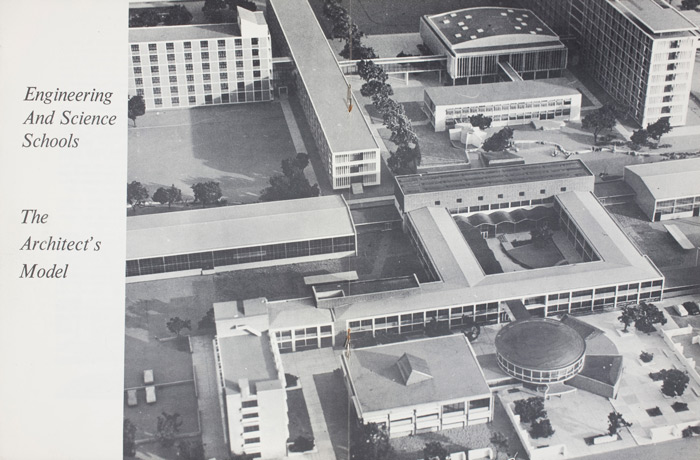Once the decision to move to a new location had been made, staff and students began to look towards the future. What would the new campus offer, and what would they take of the old? The student body began discussing their requirements in a 1951 article from Canta entitled And now we say Ilam. The article includes a proposed layout for the Riccarton campus, and noted that a student union building was to be included. Students warned that they would need a large refectory to allow for increased use by students who wouldn’t be able to pop home for lunch, and also made special mention of the University’s intention to use only single storey buildings, except for the Library which would be two storeys.

A Vision of the Future

The article And now we say Ilam from Canta, 20 June 1951, included a plan of the proposed layout of the new campus.
The School of Art were first to move to the new campus in 1957, and were accommodated in a remodeled Okeover house, with the Director’s office located in the former butler’s pantry. The first to get a completely new purpose built facility were the Engineers. Although the University authorities had pushed for Collins and Son to be involved, the government architect was responsible for the building design. Richard Harman commented at the time that he hoped the design would not too readily favour ‘modernist’ architecture, because “the modern of today can look very out of date the day after tomorrow.”
The building did have a distinctly modernist overtone, and set the scene for the increasing use of Brutalist architecture on campus. Still the University did not wish to let go of everything it had experienced on the town site. When the contract for the Engineering building was let, Prime Minister Keith Holyoake stated that every effort would be made to preserve the atmosphere of University buildings with quadrangles, and there would be continued use of local Halswell stone. In the end, the new school only incorporated Halswell stone to cover ground floor wall panels between concrete columns.
Into the 1960s, the University embarked on marketing the new site, aware of the confusion that a divided site might cause. Several booklets publicizing the move and its benefits are kept in the University Library Collection, including a brochure promoting the University to overseas academics. In the booklet The University of Canterbury they explain that “… there arose a conviction that the central site, now grossly overcrowded and disfigured by improvised tenements, could no longer accommodate a university college whose expansion was inevitable… Accordingly, the decision was taken to transfer the College, stage by stage, to a well-planted site of 151 acres at Ilam.

Promotional material for the new School of Art building proposed by Collins and Son.
There the School of Engineering already stands, expressing in its clean, straight lines a vision of the future, and in its central quadrangle a memory of the past.” The same publication suggests to potential staff that a good quality brick house in the suburbs would cost £6000, and that the institution had up-to-date research facilities at Ilam including a library with over 160,000 volumes, and technology such as the IBM 160 Digital Computer.
Some of the visions for the new campus are charming to read, especially in this age of cell phones and wi-fi. A University Moves predicted that the new Ilam site would have 5 main entrances, with a telephone at each entrance where visitors could stop and get directions, without even having to leave their cars. Marketing in the booklet optimistically states “When completed in 1970-1971, the University of Canterbury should not only be well fitted to enhance its distinguished international reputation through teaching and research: it should also provide Christchurch, Canterbury and New Zealand with an exciting and singularly beautiful complex of carefully planned modern buildings, gardens, courts, shrubberies and lawns.” The last department left the town site in 1975, and the old College buildings fell silent.

A page from A University Moves which marketed a vision of the Ilam campus. The architectural models featured are retained in the University Library's collections.